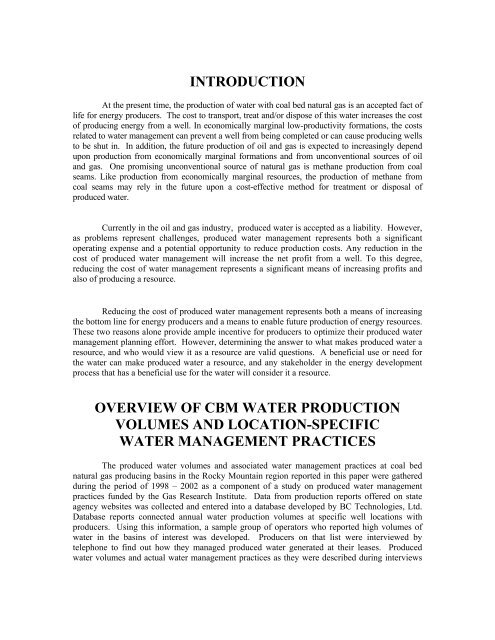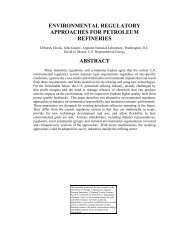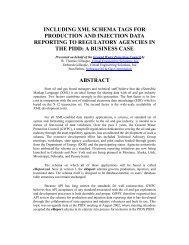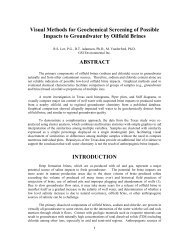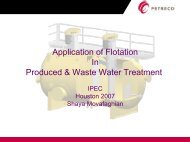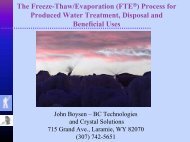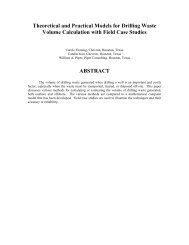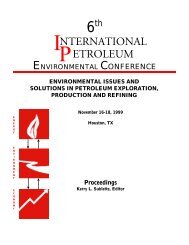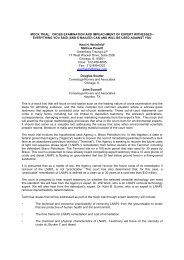Managing Produced Water at CBM Properties in the Rocky ... - IPEC
Managing Produced Water at CBM Properties in the Rocky ... - IPEC
Managing Produced Water at CBM Properties in the Rocky ... - IPEC
You also want an ePaper? Increase the reach of your titles
YUMPU automatically turns print PDFs into web optimized ePapers that Google loves.
INTRODUCTION<br />
At <strong>the</strong> present time, <strong>the</strong> production of w<strong>at</strong>er with coal bed n<strong>at</strong>ural gas is an accepted fact of<br />
life for energy producers. The cost to transport, tre<strong>at</strong> and/or dispose of this w<strong>at</strong>er <strong>in</strong>creases <strong>the</strong> cost<br />
of produc<strong>in</strong>g energy from a well. In economically marg<strong>in</strong>al low-productivity form<strong>at</strong>ions, <strong>the</strong> costs<br />
rel<strong>at</strong>ed to w<strong>at</strong>er management can prevent a well from be<strong>in</strong>g completed or can cause produc<strong>in</strong>g wells<br />
to be shut <strong>in</strong>. In addition, <strong>the</strong> future production of oil and gas is expected to <strong>in</strong>creas<strong>in</strong>gly depend<br />
upon production from economically marg<strong>in</strong>al form<strong>at</strong>ions and from unconventional sources of oil<br />
and gas. One promis<strong>in</strong>g unconventional source of n<strong>at</strong>ural gas is methane production from coal<br />
seams. Like production from economically marg<strong>in</strong>al resources, <strong>the</strong> production of methane from<br />
coal seams may rely <strong>in</strong> <strong>the</strong> future upon a cost-effective method for tre<strong>at</strong>ment or disposal of<br />
produced w<strong>at</strong>er.<br />
Currently <strong>in</strong> <strong>the</strong> oil and gas <strong>in</strong>dustry, produced w<strong>at</strong>er is accepted as a liability. However,<br />
as problems represent challenges, produced w<strong>at</strong>er management represents both a significant<br />
oper<strong>at</strong><strong>in</strong>g expense and a potential opportunity to reduce production costs. Any reduction <strong>in</strong> <strong>the</strong><br />
cost of produced w<strong>at</strong>er management will <strong>in</strong>crease <strong>the</strong> net profit from a well. To this degree,<br />
reduc<strong>in</strong>g <strong>the</strong> cost of w<strong>at</strong>er management represents a significant means of <strong>in</strong>creas<strong>in</strong>g profits and<br />
also of produc<strong>in</strong>g a resource.<br />
Reduc<strong>in</strong>g <strong>the</strong> cost of produced w<strong>at</strong>er management represents both a means of <strong>in</strong>creas<strong>in</strong>g<br />
<strong>the</strong> bottom l<strong>in</strong>e for energy producers and a means to enable future production of energy resources.<br />
These two reasons alone provide ample <strong>in</strong>centive for producers to optimize <strong>the</strong>ir produced w<strong>at</strong>er<br />
management plann<strong>in</strong>g effort. However, determ<strong>in</strong><strong>in</strong>g <strong>the</strong> answer to wh<strong>at</strong> makes produced w<strong>at</strong>er a<br />
resource, and who would view it as a resource are valid questions. A beneficial use or need for<br />
<strong>the</strong> w<strong>at</strong>er can make produced w<strong>at</strong>er a resource, and any stakeholder <strong>in</strong> <strong>the</strong> energy development<br />
process th<strong>at</strong> has a beneficial use for <strong>the</strong> w<strong>at</strong>er will consider it a resource.<br />
OVERVIEW OF <strong>CBM</strong> WATER PRODUCTION<br />
VOLUMES AND LOCATION-SPECIFIC<br />
WATER MANAGEMENT PRACTICES<br />
The produced w<strong>at</strong>er volumes and associ<strong>at</strong>ed w<strong>at</strong>er management practices <strong>at</strong> coal bed<br />
n<strong>at</strong>ural gas produc<strong>in</strong>g bas<strong>in</strong>s <strong>in</strong> <strong>the</strong> <strong>Rocky</strong> Mounta<strong>in</strong> region reported <strong>in</strong> this paper were g<strong>at</strong>hered<br />
dur<strong>in</strong>g <strong>the</strong> period of 1998 – 2002 as a component of a study on produced w<strong>at</strong>er management<br />
practices funded by <strong>the</strong> Gas Research Institute. D<strong>at</strong>a from production reports offered on st<strong>at</strong>e<br />
agency websites was collected and entered <strong>in</strong>to a d<strong>at</strong>abase developed by BC Technologies, Ltd.<br />
D<strong>at</strong>abase reports connected annual w<strong>at</strong>er production volumes <strong>at</strong> specific well loc<strong>at</strong>ions with<br />
producers. Us<strong>in</strong>g this <strong>in</strong>form<strong>at</strong>ion, a sample group of oper<strong>at</strong>ors who reported high volumes of<br />
w<strong>at</strong>er <strong>in</strong> <strong>the</strong> bas<strong>in</strong>s of <strong>in</strong>terest was developed. Producers on th<strong>at</strong> list were <strong>in</strong>terviewed by<br />
telephone to f<strong>in</strong>d out how <strong>the</strong>y managed produced w<strong>at</strong>er gener<strong>at</strong>ed <strong>at</strong> <strong>the</strong>ir leases. <strong>Produced</strong><br />
w<strong>at</strong>er volumes and actual w<strong>at</strong>er management practices as <strong>the</strong>y were described dur<strong>in</strong>g <strong>in</strong>terviews


